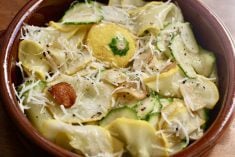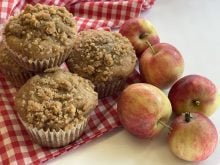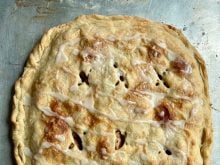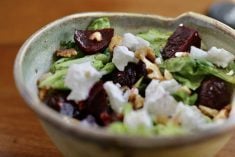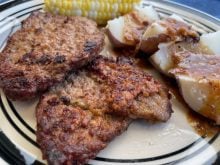I researched several recipes for interesting stews and surprisingly to me, the one thing they all had in common was no thickening agent, such as flour.
Further research told me that in soup, the liquid is the primary ingredient. Soup can be completely liquified or it can consist of other elements, like meat and vegetables, that are fully submerged in water, stock, or broth.
Stew is chunkier. It contains just enough liquid to cover the main ingredients.
Read Also

Alberta cracks down on trucking industry
Alberta transportation industry receives numerous sanctions and suspensions after crackdown investigation resulting from numerous bridge strikes and concerned calls and letters from concerned citizens
Italian vegetable stew
- 2 tbsp. olive oil 30 mL
- 4 oz. pancetta, diced 115 g
- 1 large onion, finely chopped
- 4 cloves garlic, minced
- 2 large carrots, finely chopped
- 2 stalks celery, finely chopped
- splash of dry red wine
- 1 medium zucchini, quartered lengthwise and sliced
- 1 small yellow squash, cubed
- 2 c. green beans, cut into 1-inch lengths 500 mL/2.5 cm
- 1 tbsp. Italian seasoning 15 mL
- 2 bay leaves
- 1 tsp. crushed red pepper flakes 5 mL
- 1 rind from a wedge of parmesan, optional
- 6 c.chicken or vegetable stock 1.5 L
- 128 fl. oz. can diced tomatoes 750 mL
- 3 tbsp. tomato paste 45 mL
- 115 fl. oz. can cannellini or white kidney beans, drained and rinsed 500 mL
- 1/2 small bunch kale, stems removed and chopped
- salt and freshly ground black pepper, to taste
- 1/4 c. chopped fresh parsley plus more for topping 60 mL
- freshly grated Parmesan cheese, for topping
Heat olive oil in a large Dutch oven or other heavy soup pot over medium-high heat. Add pancetta, reduce heat to medium and cook four or five minutes or until beginning to get crispy.
Add onion. Reduce heat to medium-low and cook four or five minutes or until beginning to soften. Add carrots and celery. Cook another four or five minutes.
Add Italian seasoning, bay leaves and crushed red pepper flakes and stir. Add a splash of red wine and simmer until almost evaporated.
Add zucchini, yellow squash, green beans and kale.
Add the parmesan rind, chicken or vegetable stock, tomatoes and tomato paste. Bring to a boil. Reduce heat to medium-low and simmer until all vegetables are tender.
Adjust seasoning with salt and black pepper, to taste. Remove the cheese rind and bay leaves. Add chopped fresh parsley.
Serve in bowls garnished with chopped fresh parsley and freshly grated Parmesan cheese.
The stew may be made one to two days ahead. Refrigerate until needed. It is also freezer friendly. Cool and place in airtight containers. Freeze up to three months. Makes six servings.
Beef daube
The difference between a daube and a bourginon is the cut of beef used. A daube uses a less tender cut with a longer cooking time.
- 4 slices thick-cut bacon, cut crosswise into 1-inch wide pieces 2.5 cm
- 3 1/2 lb. beef chuck or blade roast, fat removed, cut into 2 or 3- inch cubes 1.75 kg / 5 or 7.5 cm
- 2 tbsp. canola oil 30 mL
- 2 yellow onions, quartered and thinly sliced
- 6 shallots, thinly sliced
- 1 garlic head, halved horizontally, only loose papery peel removed
- 1 1/2 lb. carrots, peeled, halved crosswise and halved or quartered lengthwise 750 g
- 1/2 lb. parsnips, peeled, halved crosswise and halved or quartered lengthwise, optional 250 g
- 1/4 c. brandy 60 mL
- 1750 mL bottle of fruity red wine, such as a syrah
- 1/4 tsp. dried thyme 1 mL
- 1/4 tsp. dried rosemary 1 mL
- 1 sprig parsley
- leaves from one celery stalk
Centre a rack in the oven and preheat oven to 350 F (180 C).
Put a Dutch oven over medium heat on the stove top and add bacon. Cook, stirring, until it just browns and then transfer to a bowl.
Add one tablespoon (15 mL) canola oil to the bacon fat in the pot. Then brown the meat, in batches, on all sides. Don’t crowd the pot or the meat will steam rather than brown. Transfer the browned meat to the bowl with the bacon and season with salt and pepper.
Add remaining canola oil to the pot. Add onions and shallots. Season lightly with salt and pepper. Cook until the onions soften, about eight minutes. Add carrots, parsnips and garlic. Add brandy and turn up the heat to deglaze the pan. Scrape up all the toasted bits sticking to the bottom of the pan. Let the brandy boil for a minute and then add back the beef and bacon. Add wine and herbs. Stir to combine. Bring back to a boil.
Cover the pot with tin foil and then the lid. Place in preheated oven and cook for one hour.
At this point the meat should be fork tender, but if it isn’t, continue cooking for another 30 minutes.
Serve the beef and vegetables with the sauce. It also goes well with a pasta such as linguine. Makes six servings.
Adapted from Around My French Table by Dorie Greenspan.
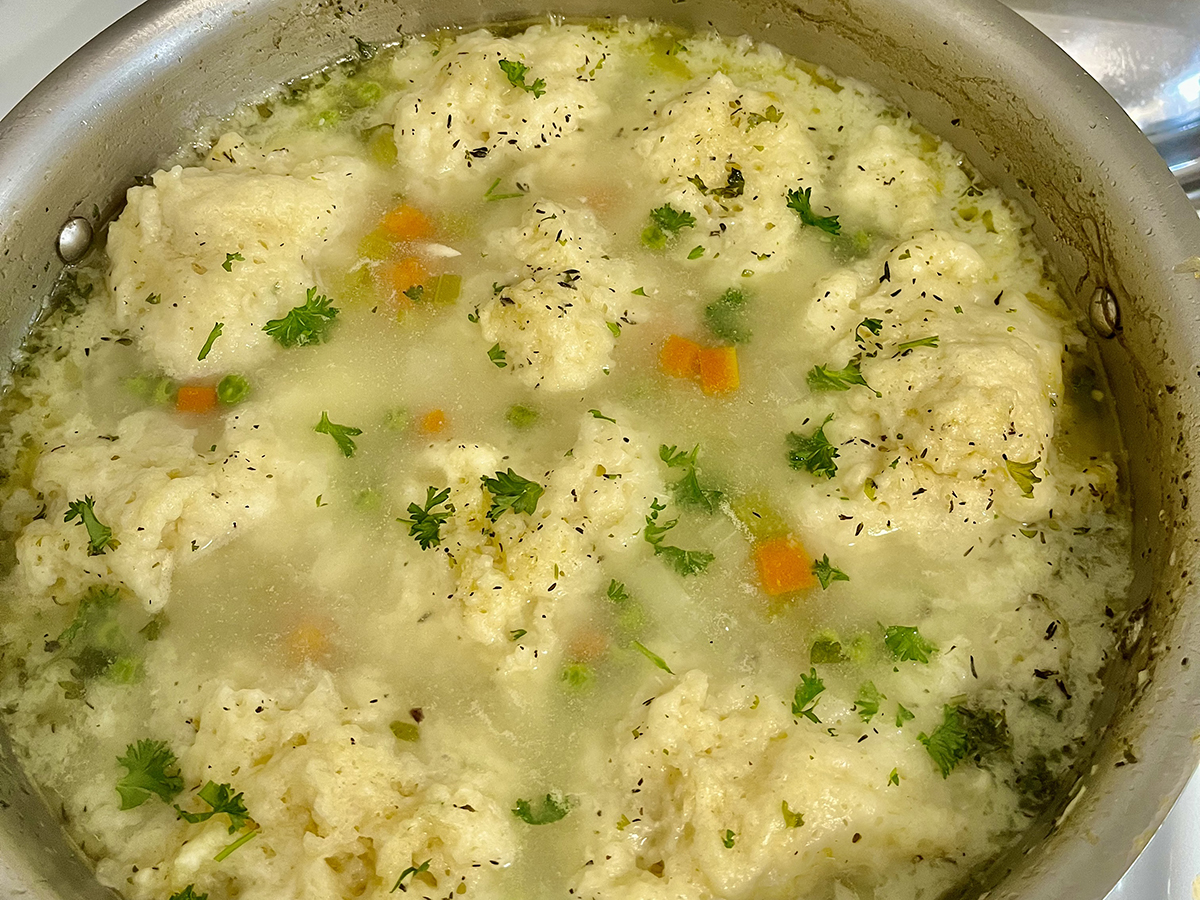
Chicken and dumplings
Simmer gently so as not to toughen the chicken and only cook until tender.
- 1 chicken
- 2 tsp. salt 10 mL
- 2 c. celery including leaves, diced 500 mL
- 2 onions, diced
- 1 1/2 c. carrots, diced 375 mL
- 1 c. turnip, diced 250 mL
- 1/2 tsp. freshly ground black pepper 2 mL
- 1/2 tsp. dried thyme 2 mL
- 2 bay leaves
- 1/4 c. fresh parsley, finely chopped 60 mL
- 1 c. fresh or frozen peas 250 mL
Dumplings
- 1 c. all-purpose flour 250 mL
- 1 1/2 tsp. baking powder 7 mL
- 1/2 tsp. salt 2 mL
- 1/4 c. chilled butter 60 mL
- 1/2 c. milk 125 mL
In a large soup pot or Dutch oven, barely cover the chicken with cold water. Add salt and bring to a boil. Cover, reduce heat and simmer for about two hours or until the meat is very tender. Occasionally skim foam that collects on the surface and add more water as needed.
Remove chicken from the pot. Let it cool and remove meat from bones and roughly chop into bite size pieces. Discard bones.
Skim the fat from the stock or allow it to cool so the fat solidifies for easy removal. Return stock to medium-high heat and add celery, onions, carrots, turnip and tomato. Season with pepper, thyme, bay leaves and parsley. Reduce heat, cover and simmer until the vegetables are just tender. Taste and adjust the seasonings as needed. Remove bay leaves. Stir in peas and reserved chicken meat.
Meanwhile, make dumplings by whisking together flour, baking powder and salt in a small bowl. Cut in the butter until it resembles fine crumbs. Add milk all at once and stir quickly to blend.
Drop the batter by spoonfuls onto the simmering stew. Cover tightly and cook over medium heat for seven minutes without removing the lid. The dumplings will more than double in size.
Ladle chicken stew and dumplings into warmed serving bowls.
Adapted from Anita Stewart’s Canada.
Lamb tagine with apricots
Lamb tagine is a thick, savoury Moroccan stew simmered in North African spices and topped with crunchy almonds and sweet dried apricots.
- 2 tbsp. olive oil 30 mL
- 2 yellow onions, diced
- 3 large carrots, cut into large pieces
- 3 cloves garlic, thinly sliced
- 1 tbsp. fresh ginger, grated 15 mL
- 2 lbs. lamb stew meat, shoulder or leg, cubed 1 kg
- pinch saffron threads
- 1 cinnamon stick
- 2 tsp. coriander seeds, crushed 10 mL
- 1 1/2 tsp. ground turmeric 7 mL
- 1 1/2 tsp. ground cumin 7 mL
- 1/2 tsp. ground cardamom 2 mL
- kosher salt and freshly ground black pepper
- 2 c. chicken stock 250 mL
- 8 dates, pitted and chopped
- 8 dried apricots, chopped
- 1/2 small orange, juiced and zested or peel thinly sliced into strips
- parsley, finely chopped
- slivered almonds, toasted
Add olive oil to the tagine or Dutch oven and spread it around to coat the bottom evenly. Make a base layer by adding chopped onions, carrots, garlic and grated ginger.
Add lamb and then all the spices. Pour chicken stock down the side of the tagine and nestle everything into the liquid.
Cook on the stovetop over low heat for about two hours or until everything is fully cooked and meat is very tender.
Add the dates, apricots and orange juice and peel or zest, stir to mix and cover. Simmer for 20 minutes.
Garnish with chopped parsley and toasted almonds.
Sarah Galvin is a home economist, teacher and avid supporter of local food producers. She has been a market vendor, grew up on a farm in southeastern Saskatchewan and is a member of TEAM Resources.




